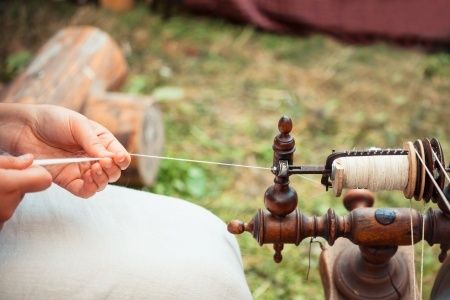From a Plant to a Wedding Gown: Lessons from Fine Linen
Written by Janice S. Miracle
 Transforming flax into linen isn’t an easy or quick process. But “fine linen, clean and bright” is beautiful enough for a bride to wear.
Transforming flax into linen isn’t an easy or quick process. But “fine linen, clean and bright” is beautiful enough for a bride to wear.
Like most young girls, I dreamed of my wedding day. I imagined my Prince Charming riding up on his white steed, scooping me up behind him and galloping away to our wedding. My flowing gown wasn’t made of satin or silk, but of fine white linen. Even as an adult, my heart was set on a beautiful gown made of the purest of fine white linen.
Later, I discovered in the pages of God’s Word many examples that hint of the process that transforms flax into linen, such as Joshua 2:6 and Proverbs 31:24. Fine linen is mentioned numerous times throughout the Scriptures—from priestly garments to the linen strips wrapped around Christ’s dead body in the tomb (Exodus 39; Mark 15:46). One of the most striking examples is the description of the Bride of Christ who is dressed in “fine linen, clean and bright” (Revelation 19:8).
From flax to linen
Before I retired, I worked as a park ranger and was involved in living history educational programs. My career gave me the opportunity to study the art of linen production. The objective was to assure the authenticity of the period clothing used in these living history programs. I learned that, until the latter part of the 19th century, turning flax into linen was very difficult. Producing fine white linen took up to 18 months.
Think about the steps needed to create enough linen for a garment:
- Plant flax seeds in early spring.
- Harvest the plant in late summer.
- Sort plants and place in water, soaking (retting) for six to eight weeks.
- Using a flax brake to break stalks and separate the outer husk from the fibers.
- Comb fibers using a hatchel or large spikes to separate the fibers into fine strands.
- Spin fibers into thread on a flax or spinning wheel.
- Place thread on a loom and weave into cloth.
- Once cloth is woven, the linen goes through a process of bleaching. This is done by dipping the linen in a combination of cow dung and lye and then laying the linen in the sun to dry for two or more weeks. To make the finest and brightest white linen, this process was done repeatedly for months.
Lessons learned
The labor-intensive process of making fine white linen offers us many lessons:
- Christianity is not easy. Just as processing flax into linen is a long, arduous task, the process of growing in godly character is work (1 Corinthians 9:27; 2 Peter 1:10). Both require time, hard work, determination, tenacity and patience.
- We must be changed. That change begins in our lives today. We must be transformed from carnal to spiritual (Romans 8:6). The apostle Paul describes this transformation as “the renewing of your mind” (Romans 12:2). But we know the ultimate change is being transformed into a spirit being—Christ’s stunning, glorious and beautiful Bride! We cannot even fully imagine what life will be like as a glorified spirit being (1 Corinthians 15:50-54; 1 John 3:2).
Just as when I was a child I eagerly awaited my physical wedding, I now (with the rest of God’s people) await my next wedding: “‘Let us be glad and rejoice and give Him glory, for the marriage of the Lamb has come, and His wife has made herself ready.’ And to her it was granted to be arrayed in fine linen, clean and bright, for the fine linen is the righteous acts of the saints” (Revelation 19:7-8).
Janice Miracle is a retired U.S. park ranger and attends the London, Kentucky, congregation of the Church of God, a Worldwide Association.










